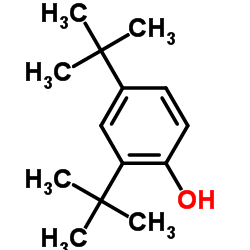2,4-Di-t-butylphenol

2,4-Di-t-butylphenol structure
|
Common Name | 2,4-Di-t-butylphenol | ||
|---|---|---|---|---|
| CAS Number | 96-76-4 | Molecular Weight | 206.324 | |
| Density | 0.9±0.1 g/cm3 | Boiling Point | 265.5±9.0 °C at 760 mmHg | |
| Molecular Formula | C14H22O | Melting Point | 53-56 °C(lit.) | |
| MSDS | Chinese USA | Flash Point | 115.0±0.0 °C | |
| Symbol |


GHS07, GHS09 |
Signal Word | Warning | |
|
Development and application of a non-targeted extraction method for the analysis of migrating compounds from plastic baby bottles by GC-MS.
Food Addit. Contam. Part A. Chem. Anal. Control. Expo. Risk Assess. 31(12) , 2090-102, (2014) In 2011, the European Union prohibited the production of polycarbonate (PC) baby bottles due to the toxic effects of the PC monomer bisphenol-A. Therefore, baby bottles made of alternative materials, e.g. polypropylene (PP) or polyethersulphone (PES), are cur... |
|
|
Cellular apoptosis and cytotoxicity of phenolic compounds: a quantitative structure-activity relationship study.
J. Med. Chem. 48 , 7234-42, (2005) In this comprehensive study on the caspase-mediated apoptosis-inducing effect of 51 substituted phenols in a murine leukemia cell line (L1210), we determined the concentrations needed to induce caspase activity by 50% (I50) and utilized these data to develop ... |
|
|
Human exposure assessment to a large set of polymer additives through the analysis of urine by solid phase extraction followed by ultra high performance liquid chromatography coupled to tandem mass spectrometry.
J. Chromatogr. A. 1423 , 111-23, (2015) Polymer items are extensively present in the human environment. Humans may be consequently exposed to some compounds, such as additives, incorporated in these items. The objective of this work is to assess the human exposure to the main additives such as thos... |
|
|
Analytical strategy based on the combination of gas chromatography coupled to time-of-flight and hybrid quadrupole time-of-flight mass analyzers for non-target analysis in food packaging.
Food Chem. 188 , 301-8, (2015) The potential of an advanced analytical strategy based on the use of gas chromatography (GC) coupled to high resolution mass spectrometry (HRMS) with two different analyzers and ionization sources has been investigated and applied to the non-target analysis o... |
|
|
The first catalytic tyrosinase model system based on a mononuclear copper(I) complex: kinetics and mechanism.
Angew. Chem. Int. Ed. Engl. 49(36) , 6438-42, (2010)
|
|
|
Non-targeted multi-component analytical surveillance of plastic food contact materials: Identification of substances not included in EU positive lists and their risk assessment.
Food Addit. Contam. 22(10) , 1012-22, (2005) A procedure used by the Norwegian Food Safety Authority for surveillance of contaminants from plastic food contact materials (polyolefin drinking bottles, water boilers, polyamide cooking utensils and plastic multi-layer materials) is described. It is based o... |
|
|
Function and immunocytochemical localization of two novel odorant-binding proteins in olfactory sensilla of the scarab beetle Holotrichia oblita Faldermann (Coleoptera: Scarabaeidae).
Chem. Senses 37(2) , 141-50, (2012) Odorant-binding proteins (OBPs) are found in both insects and vertebrates, and it is believed that they are involved in chemical communication. In this study, we identify and express 2 OBPs from the scarab beetle, Holotrichia oblita Faldermann (Coleoptera: Sc... |
|
|
Determination of xenobiotic intrinsic clearance in freshly isolated hepatocytes from rainbow trout (Oncorhynchus mykiss) and rat and its application in bioaccumulation assessment.
Environ. Sci. Technol. 41(9) , 3269-76, (2007) Bioaccumulation in fish depends on the dynamics of various processes that involve fish uptake, storage, and elimination of xenobiotics. Elimination via fish biotransformation is a primary process that can be evaluated in an in vitro system to improve the perf... |
|
|
Isolation and characterization of a novel 2-sec-butylphenol-degrading bacterium Pseudomonas sp. strain MS-1.
Biodegradation 21(2) , 157-65, (2010) A novel bacterium capable of utilizing 2-sec-butylphenol as the sole carbon and energy source, Pseudomonas sp. strain MS-1, was isolated from freshwater sediment. Within 30 h, strain MS-1 completely degraded 1.5 mM 2-sec-butylphenol in basal salt medium, with... |
|
|
Root treatment with rhizobacteria antagonistic to Phytophthora blight affects anthracnose occurrence, ripening, and yield of pepper fruit in the plastic house and field.
Phytopathology 101(6) , 666-78, (2011) We previously selected rhizobacterial strains CCR04, CCR80, GSE09, ISE13, and ISE14, which were antagonistic to Phytophthora blight of pepper. In this study, we investigated the effects of root treatment of rhizobacteria on anthracnose occurrence, ripening, a... |